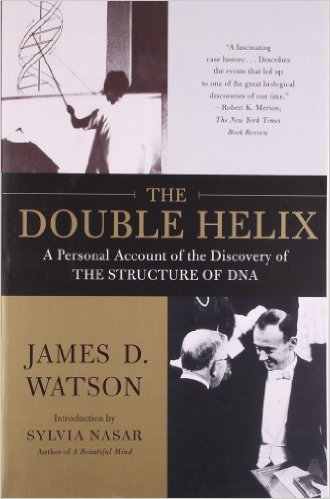Book Review: The Double Helix
The Double Helix:
A Personal Account of the Discovery of the Structure of DNA
by James D. Watson
Review by Nate Adema
Dr. James Watson was at the center of arguably the greatest scientific discovery of the 20th century: the discovery of DNA’s structure.The Double Helix – A Personal Account of the Discovery of The Structure of DNA is Watson’s very personal firsthand account of the discovery and dispels many notions outsiders may have about how science really works. Drawing from his own recollections of the months and days leading up to the discovery, he gives a detailed and candid account of the race to solve this puzzle. In the introduction, Watson states openly that his account is a story told from his own point of view, complete with possible faulty memories and personal prejudices.
The events of the book occur during the early 1950’s and take place primarily in England. Watson leads readers chronologically through a series of scientific discoveries and setbacks, while also exposing the human elements of scientific work. He begins by introducing the major players in the three-team race: Francis Crick, Maurice Wilkins, Rosalind Franklyn, and Linus Pauling. Each person is described in physical detail as well as their interesting personality traits. Crick, Watson’s partner, was a loud, “big ideas” person who had a natural curiosity about most scientific things in life yet hadn’t quite moved into the expected role of college professor. Wilkins was great with the research details but was not able to see the big picture and had difficulty communicating with others. Franklyn, the only female in the group, was defensive and confrontational at times, according to Watson, and clashed with Wilkins’ personality even though they were supposed to be working together on the DNA structure project. Pauling was a superstar American chemist who had a flair for the dramatic and enjoyed attention. He was brilliant and known for solving any problems he put his mind to. Throughout the book the humanness of doing science is seen in the interplay of these varied personalities and it is surprising to realize how significant of a role personality played in DNA’s discovery.
Along with the personality descriptions, Watson provides a heavy dose of biochemistry, going into detail about X-ray Crystallography and the various techniques used by each group. Watson provides insight into the reasons for the shift away from protein-based research as a means of uncovering genetics and heredity and toward DNA-based research. The amount of scientific detail may be overwhelming or hard to follow without a PhD in one of the fields, yet Watson’s writing keeps a good pace and he is able to swing from heavy biochemical details to personality conflicts to English cultural engagements within single chapters.
While candid with his views and reporting, Watson does not spend much time dealing with the controversy that followed their use of Wilkins’ and Franklyn’s unpublished data. He closes the book by focusing primarily on the biochemistry of the discovery and less on the emotions of the events and the nature of science inquiry as it played out among competing methods and people. Yet in a touching moment at the end of the book he admits that his unfavorable impressions of Rosalind Franklin stemmed from the fact that she was a woman trying to make a name for herself in the male-dominated world of scientific research in the 1950s. Watson’s descriptions of the competition, politics, dead ends, personality clashes, mistakes, and eventual inspiration reveal that discovery is not s clear-cut process, but is a combination of the world and the people who live in it.

